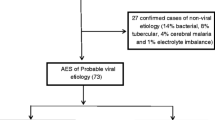Abstract
Background
The incidence of acute symptomatic (at the time of documented brain insult) seizures and single unprovoked seizures are 29-39 and 23-61 per 100 000 per year, respectively. After stabilization of the patient, finding the etiology of the seizure is of paramount importance. A careful history and physical examination may allow a diagnosis without need for further evaluation.
Methods
In the literature, severe central nervous system involvement has been reported from human parvovirus B19 infection. We reported a previously healthy 7-year-old girl who presented after an episode of focal seizure. She was afebrile and didn’t have any focal neurological abnormalities. She had erythematous malar rash along with reticulating pattern of rash over her both upper extremities.
Results
Parvovirus infection was suspected due to the characteristic erythematous malar rash. Serum human parvovirus B19 DNA polymerase chain reaction was positive which was consistent with acute parvovirus infection. Further confirmation of current infection was done with Sandwich enzyme immunoassays showing positive anti-B19 IgM Index (>1.1). IgG index was equivocal (0.9-1.1).
Conclusions
We report an extremely rare presentation of non-febrile seizure from acute parvovirus infection in a child without encephalopathy who had an excellent recovery. Timely diagnosis can provide counselling regarding future seizure recurrence risk, curtail expenditure from expensive diagnostic work up and provide additional recommendations about potential risks to a pregnant caregiver.
Similar content being viewed by others
References
Hauser WA, Beghi E. First seizure definitions and worldwide incidence and mortality. Epilepsia 2008;49 Suppl 1:8–12.
Young NS, Brown KE. Parvovirus B19. N Engl J Med 2004;350: 586–597.
Boeck K, Mempel M, Schmidt T, Abeck D. Gianotti-Crosti syndrome: clinical, serologic, and therapeutic data from nine children. Cutis 1998;62:271–274; quiz 286.
Mage V, Lipsker D, Barbarot S, Bessis D, Chosidow O, Del Giudice P, et al. Different patterns of skin manifestations associated with parvovirus B19 primary infection in adults. J Am Acad Dermatol 2014;71:62–69.
Cohen BJ, Buckley MM. The prevalence of antibody to human parvovirus B19 in England and Wales. J Med Microbiol 1988; 25:151–153.
Douvoyiannis M, Litman N, Goldman DL. Neurologic manifestations associated with parvovirus B19 infection. Clin Infect Dis 2009;48:1713–1723.
Erol I, Alehan F, Yalcin K. Refractory status epilepticus owing to human parvovirus B19 encephalitis in a child. J Child Neurol 2006;21:820–822.
Hsu D, Sandborg C, Hahn JS. Frontal lobe seizures and uveitis associated with acute human parvovirus B19 infection. J Child Neurol 2004;19:304–306.
Barah F, Vallely PJ, Cleator GM, Kerr JR. Neurological manifestations of human parvovirus B19 infection. Rev Med Virol 2003;13:185–199.
Hirtz D, Ashwal S, Berg A, Bettis D, Camfield C, Camfield P, et al. Practice parameter: evaluating a first nonfebrile seizure in children: report of the quality standards subcommittee of the American Academy of Neurology, The Child Neurology Society, and The American Epilepsy Society. Neurology 2000;55:616–623.
Author information
Authors and Affiliations
Corresponding author
Rights and permissions
About this article
Cite this article
Samanta, D., Willis, E. Focal seizure associated with human parvovirus B19 infection in a non-encephalopathic child. World J Pediatr 12, 118–120 (2016). https://doi.org/10.1007/s12519-015-0060-0
Received:
Accepted:
Published:
Issue Date:
DOI: https://doi.org/10.1007/s12519-015-0060-0




